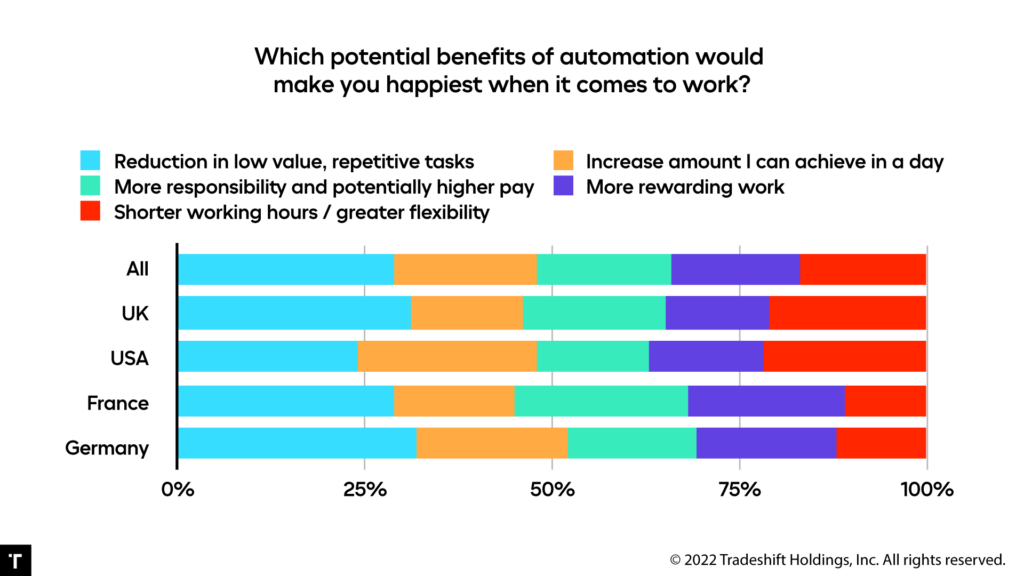Automation in the workplace – what employees think about it
What do employees really think when it comes to robots and automation in the workplace?
After years of hype, automation came into its own during the pandemic. Companies around the world found that existing resources, human capital and processes could not scale in the face of a crisis.
It’s no big secret that automation is capable of doing certain tasks better, faster and cheaper than employees. Against a backdrop of labor shortages and economic headwinds, companies across all industries are betting on a “digital-first” future where machines take over more day-to-day tasks.
When change happens quickly, it creates a healthy tension that is equal parts hype and fear. Most of the time, it’s somewhere in between. Proponents of automation often emphasize the “human dividend” that comes from handing over a series of mundane and repetitive tasks to machines, allowing workers to focus their time and effort on more rewarding, strategic tasks.
But that hasn’t stopped workers from thinking about what the future holds for them. A recent study by KPMG found that workers’ anxiety about automation increased during the pandemic. Two-thirds of U.S. workers said they were worried about their jobs. Their employers had taken steps to reduce costs, streamline processes and increase efficiency through automation. (E.g., the article on automation in accounting).
Index
Familiarity makes happy
Finance and accounting regularly feature on the list of tasks most suitable for automation. According to a study by Mckinsey, 42% of finance activities can be automated with the technologies currently in use, and another 19% can be largely automated.
To better understand how workers are coping with this transition, Tradeshift conducted a survey of accounting professionals in the US, UK, Germany and France. It looked at their hopes, fears and, most importantly, their experiences with automation.
Nearly three-quarters (71%) of respondents do not see automation as an existential threat. They believe that technology will have a positive impact on their job satisfaction. The study clearly shows that employee satisfaction increases with the degree of automation. In countries where automation is widespread, employees are not only more optimistic about job security. They are also more satisfied with their jobs and would be more likely to recommend their job to someone else entering the job market.
In the U.S., where nearly three-quarters (72%) say the level of automation in their department is already very high, the same number (75%) said they are satisfied with their job. In Europe, the level of automation is lower: half of workers in the UK say that automation is already very advanced, compared with just 37% in Germany and 21% in France. These figures are closely related to satisfaction, morale, perceived job security and the likelihood of recommending one’s job to others. In the UK, 55% of employees said they were very satisfied with their jobs, compared with 44% in France and just 40% in Germany.
Higher pay, less stress
It’s hard to escape the conclusion that the oft-expressed fear of automation is misplaced. When asked what employees found least satisfying about their jobs, they indicated that it was the boring, repetitive tasks that had the most negative impact on overall satisfaction. Long hours and a heavy workload also contributed to low satisfaction.
One of the promises of automation is that machines will finally take over repetitive and objectively boring work, such as entering data and fixing small errors that cause bottlenecks. Not surprisingly, respondents cited the elimination of low-value, repetitive tasks as the item most likely to make them more satisfied among the benefits they see in automation. A similar proportion said automation would help them climb the career ladder faster while maintaining a healthier work-life balance.

Would you work for a robot?
Clearly, automation leads to greater job satisfaction, but workers would certainly be reluctant to take instructions from a robot – right?
Surprisingly, many said they would have no problem taking instructions from a machine. Nearly half of workers in the U.S. and U.K., where automation is most advanced, said they would trust software to be a better supervisor than their current boss. According to the statements, technology is more effective than humans at identifying and solving problems, reviewing work and making decisions.
A lesson from history
Managing change is not always easy. The best technologies are there to change and challenge the status quo. At a time when many traditional entry-level jobs are becoming highly automated, employers need to re-evaluate their approach to hiring and developing career paths for junior staff. Investments in technology must be matched by investments in skills and training.
Technology will not replace people. In every generation, there has been a moment when traditional processes and job roles have been challenged by new tools and technologies. Each time, the elimination of a set of tasks has created opportunities for higher-skilled, higher-paying jobs.
The Tradeshift study “Are Friends Electric?”
Tradeshift commissioned market research firm Coleman Parkes to conduct an online survey examining the attitudes of 500 finance and accounting professionals in the US, UK, France and Germany towards automation. The survey took place in April 2022. Respondents ranged from junior to mid-level finance executives at mid-sized and large companies. All respondents have a high level of understanding of the investments their company had made in technologies related to automation in their current workplace.
The full report, “Are Friends Electric?” is available here.
Author: Mikkel Hippe Brun, General Manager Payment Automation, Tradeshift

Comments are closed.